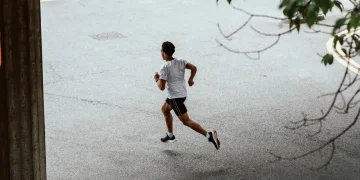Breathing is arguably the most important – and overlooked – part of any physical activity, not just running. Whenever we do anything more challenging than walking, our bodies require lots of oxygen to keep up with the increased energy consumption. Furthermore, proper breathing while running may boost your speed and distance from a casual 20-minute jogger to a competitive half-marathon participant.
Breathing Techniques for Running
We’ve gathered several breathing tips you may implement during your next running session. But, don’t go all out and try them all at once – approach each method carefully and one at a time.
Breathe with Your Belly
Professional runners know how to relax the parts of their upper bodies that are not directly involved in running, including the head, neck, shoulders, and chest. Inexperienced joggers often use the latter for breathing, which leads to unnecessary tension and prevents them from inhaling a proper amount of air.
What you should do instead is concentrate on breathing with your abdomen. This allows you to relax the torso muscles, get more oxygen, and ultimately run a longer distance.
Many people find this technique difficult at first, but with a bit of practice, you should get the hang of it pretty fast. Try this exercise at home:
- Lie on the couch or the floor facing up.
- Put a book or a hand on your stomach.
- Slowly inhale using only your nose (8-10 seconds). Focus on the diaphragm. Notice how the book or your hand rises above the chest area.
- Exhale by slowly releasing air through the mouth (8-10 seconds). Pay attention to how your stomach muscles relax.
- Do this routine 10 times, gradually increasing inhaling and exhaling intervals.
Once you become a natural with diaphragmic breathing, you can start using this technique for running. It is also beneficial for people who use their voice as a tool, for example, singers, actors, or TV hosts.
Breathe Rhythmically
Each runner has a distinct breathing pattern they use during running. Most people prefer the 3:3 ratio, which means they inhale for 3 steps and then exhale for another 3 steps. For high-intensity intervals, it’s common to switch to 2:2 or 1:1 (recommended only for very short sprint sections).
Some sources, such as the American Lung Association, suggest that even patterns like these may cause discomfort or, in some cases, injuries. The reason behind this theory is that the beginning of each inhalation and exhalation cycle always starts with the same foot, which means that one side of the body is subject to more stress than the other.
To avoid this, scientists recommend going with 3-step inhales followed by 2-step exhales. The 3:2 method splits the impact of landing between both sides of the body equally and lowers the risk of injury. However, there’s not enough evidence to either support or dismiss this theory.
Whatever your pattern is, it has to feel natural and easy enough for you to be able to maintain it through most of your running session. To find the perfect rhythm, try a simple test. Run with a partner and have a conversation with them – you should be able to speak comfortably without getting out of breath while running.
If done right, rhythmic breathing can have a calming effect on your body and help you improve your mood by increasing the volume of dopamine.
Nose vs. Mouth
People have debated for ages whether everyone should breathe through the nose or mouth when running.
The pro-nose camp believes that nose breathing allows runners to:
- Receive cleaner air thanks to nasal filtration mechanisms;
- Receive warmer air which is more lung-friendly (especially in cold weather);
- Improve the belly-breathing technique;
- Keep their mouths moist.
In the other corner, we have mouth breathers who live and die by the following beliefs:
- The mouth is able to suck more air than the nose;
- Mouth breathing keeps the face muscles relaxed;
- Exhaling through the month allows runners to get rid of more carbon dioxide.
In reality, both of them are right. The primary function of breathing is to fuel your body with as much oxygen as possible. With that being said, the best way to breathe while running is to use both your nose and mouth simultaneously for inhaling and your mouth only for exhaling. As the legendary running coach Arthur Lydiard once put it, “Breathe through the mouth, breathe through the nose, suck it in through the ears if you can.”
Breathing Techniques after Running
If you need to quickly recover between sprints or after a long, intense run, try to bend over and put your hands on your knees. Studies show that this pose slows down the heart rate faster and fills the lungs with air more efficiently by increasing their active surface.
After you finish running, walk for a couple of minutes while taking slow deep breaths through the nose. And don’t forget to stretch!
How to Improve Breathing
If you still find it hard to adjust your breathing, here are a few additional tips to get you going.
Run Every Day
Practice makes perfect. By running regularly, you will get stronger and more resistant to fatigue, and your muscles will gradually get used to more oxygen.
Swim
Swimming is a great way to learn how to control breathing during long physical activities. It is easier to understand how rhythmic breathing works and will teach your body to receive more oxygen through limited inhales.
Do Breathing Exercises
Practice breathing on a daily basis. There are a lot of effective yoga techniques for relaxation and stress relief, such as Sitali breath, sama vritti, equal breathing, etc. For more exercises, head here.
Don’t Smoke
It goes without saying that smoking is bad for your health, but it’s especially devastating to your respiratory system. If you’re a regular smoker, try to reduce your daily dose of cigarettes or quit altogether.
Breathe Clean Air
Buy an air purifier or humidifier to improve the quality of oxygen at home. Clean up your living area daily to remove dust and other unwanted elements. When running, plan your route to avoid both car and human traffic as much as possible.
To learn even more about why breathing correctly is important and how to do it. You can read other articles on the topic.
Conclusion
Now that you know more about breathing, it’s time to put it to the test. Lace up the sneakers and get going! We hope you’ll soon see big improvements in your running abilities as well as your quality of life!






